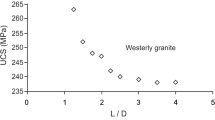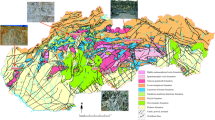Abstract
One of the parameters which affect the uniaxial compressive strength (UCS) of rock materials is the length to diameter ratio (L/D) of test cores. ASTM recommends a ratio of between 2 and 2.5, and ISRM suggests 2.5–3:1. Research has shown that high UCS values are obtained for L/D ratios <2, a very slight difference in values between 2 and 2.5, and they remain effectively constant with a L/D ratio >2.5:1. In this study, the shape effect on the UCS of seven rocks was investigated by testing dry cores with L/D ratios from 1 to 2.5:1. Based on the results, a decrease in UCS with increasing L/D ratios up to 2.5:1 was measured for all the rocks except the tuff. By omitting the data from the tuff sample, a correction formula was determined for the rocks tested in this study and results obtained from the literature. However, further work is required on different types of rock to verify or modify this formula.










Similar content being viewed by others
References
ASTM (1994) American Society for Testing and Materials. Annual book of ASTM standards, vol 04.08, Philadeplhia, PA, USA
ASTM (2000) American Society for Testing and Materials. Annual book of ASTM standards, vol 04.08, Philadeplhia, PA, USA
Bieniawski ZT (1968) The effect of specimen size on compressive strength of coal. Int J Rock Mech 5:325–335
Bieniawski ZT (1972) Propagation of brittle fracture in rock. In: Proceedings of 10th symposium on rock mechanics, AIME, Newyork, pp 409–427
Coates DF (1965) Rock mechanics principles. Mines branch monograph 874. Queen’s Print, Ottawa, Canada, p 280
Gercek H (2008) Personal communication. Zonguldak Karaelmas University, Department of Mining Engineer. Zonguldak, Turkey
Hawkins AB (1998) Aspects of rock strength. Bull Eng Geol Environ 57:17–30
Hodgson K, Cook NGW (1970) The effects of size and stress gradient on the strength of rock. In: Proceedings of 2nd Congress of International Society of Rock Mechanics, vol 2, Belgrade, pp 3–5
Hoek E, Brown ET (1980) Underground excavations in Rock. Institution of Mining and Metallurgy. Stephen Austin and Sons Ltd., Hertford, London, p 527
Hoskins JR, Horino FG (1969) The influence of spherical head size and specimen diameter on the uniaxial compressive strength of rocks. US Bureau of Mines Report of Investigations, 7234, p 16
Hudson JA, Harrison JP (1997) Engineering Rock Mechanics: an introduction to the principles. Pergamon, p 444
ISRM (2007) The complete ISRM suggested methods for rock characterization, testing and monitoring: 1974–2006. In: Ulusay R, Hudson JA (eds) Suggested methods prepared by the commission on testing methods, ISRM, Compilation arranged by the ISRM Turkish National Group, Kozan ofset, Ankara
John M (1972) The influence of length to diameter ratio on rock properties in uniaxial compression: a contribution to standardisation in rock mechanics testing. Rep S Afr CSIR No ME1083/5
Kahraman S, Alber M (2006) Estimating unconfined compressive strength and elastic modulus of a fault breccia mixture of weak blocks and strong matrix. Int J Rock Mech Mining Sci 43:1277–1287
Lockner DA (1995) Rock failure. In: Thomas JA (ed) Rock physics and phase relations. A handbook of physical constants, AGU References Shelf 3, pp 127–147
Mogi K (1962) The influence of the dimensions of specimens on the rock fracture strength of rocks. Bull Earthq Res Inst Tokyo Univ 40:175–185
Mogi K (1966) Some precise measurements of fracture strength of rocks under uniform compressive stress. Felsmechanik und Ingenieurgeologie 4:41–55
Mogi K (2007) Experimental rock mechanics. Taylor & Francis, London, p 361
Obert L, Duvall WI (1967) Rock mechanics and the design of structures in rock. Wiley, London, p 650
Obert L, Windes SL, Duvall WI (1946) Standardized tests for determining the physical properties of mines rocks. US Bureau of Mines Report of Investigations, 3891, p 1
Pratt HR, Black AD, Brown WS, Brace WR (1972) The effect of specimen size on the mechanical properties of unjointed diorite. Int J Rock Mech Mining Sci 9:513–529
Protodyakonov MM (1969) Method of determining the strength of rocks under uniaxial compression. In: Protodyakonov MM, Koifman GI et al (eds) Mechanical properties of rocks. Israel program for scientific translations, Jerusalem (translated from Russian)
Protodyakonov MM, Koifman MI (1963) The scale effect in investigations of rock and coal. In: Proceedings of 5th congress international bureau rock mechanics, Leipzig
Thuro K, Plinninger RJ, Zäh S, Schütz S (2001) Scale effects in rock strength properties. Part 1: Unconfined compressive test and Brazilian test. In: ISRM regional symposium, EUROCK 2001, Rock mechanics—a challenge for society, Finland, pp 169–174
Unlu T, Yilmaz O (2008) Investigation of the shape effect on the uniaxial compressive strength of the intact rock. In: Türk N, Deliormanlı AH, Kıncal C (eds) 9th regional rock mechanics symposium Izmir, Turkey, pp 121–141
Author information
Authors and Affiliations
Corresponding author
Rights and permissions
About this article
Cite this article
Tuncay, E., Hasancebi, N. The effect of length to diameter ratio of test specimens on the uniaxial compressive strength of rock. Bull Eng Geol Environ 68, 491–497 (2009). https://doi.org/10.1007/s10064-009-0227-9
Received:
Accepted:
Published:
Issue Date:
DOI: https://doi.org/10.1007/s10064-009-0227-9




